The Impressive Acting Range of Kinnosuke
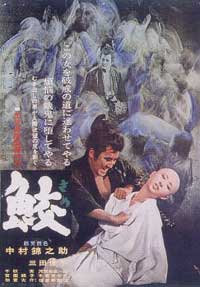 Set in Echizan province in the 1500s, Shark (Same, Toei, 1964) is based on a novel by Nobuhiko Matsugi. We are at first introduced to a sweet, innocent, & impovershed shark fisherman (Kinnosuke Nakamura Yorozuya) whose name is Same (Sah-Meh, Shark). He is the bastard son of a Buddhist priest & his uncle is a peasant arrowsmith.
Set in Echizan province in the 1500s, Shark (Same, Toei, 1964) is based on a novel by Nobuhiko Matsugi. We are at first introduced to a sweet, innocent, & impovershed shark fisherman (Kinnosuke Nakamura Yorozuya) whose name is Same (Sah-Meh, Shark). He is the bastard son of a Buddhist priest & his uncle is a peasant arrowsmith.
After their poor village is burned & his mother killed, he meets a woman while on the road, & she tricks him into eating human flesh. He flees the cannible woman & next comes to the throwing-old-people-away place by the river.
If this sounds a bit surreal, it is filmed in such a way as to increase the sense of a dream or folktale come to life. And Kinnosuke is playing a character who had formerly been decent but whose decay is documented in the most strikingly unsentimental terms.
A one-armed man takes Same under his wing & teaches him to be a thief. Life as a thief transforms him into a cold-blooded murderer, delighting especially in killing aristocrats who were the only ones left uninjured by famine. While peasants starve, rice is sent to bankers to be turned into sake for samurai, aristocrats, & priests. Same attacks rice shipments which has the repurcussion of a police massacre of starving peasants.
Maltreated by his one-armed mentor, Same eventually turns on him, then becomes independently monstrous as he heads out alone to become "a footman," with the dream of getting ahead as a samurai.
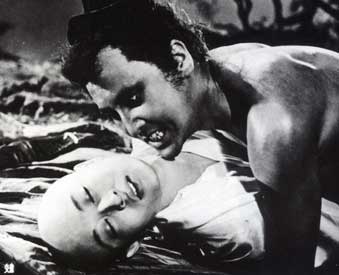 Same participates in a hugely staged battle which is shown to be clumsy, unheroic, brutal & dirty. Same participates in a hugely staged battle which is shown to be clumsy, unheroic, brutal & dirty.
True to his name, he is a shark in battle, & in the wake of the fight he loots armor to sell, like a shark eating corpses.
He even manages cleverly to switch sides in the midst of battle so as to assure being on the winning side. In the wake of the fight, he postures self-importantly, but gains no reward or status, so goes back to burglaring.
Same also becomes a scary sexual psychopath raping & killing women for fun. But then a passive nun scares the bejabbers out of him with her refusal to struggle, with just a hint of the supernatural.
The film provides some excellent, stagey photography effects in conveying a personality desintegrating into madness as a response to an unjust world. Grim though it gets, the story nevertheless searches for a healing ending as Same overcomes what had become his bitterness & his own evil nature. When at long last he returns to Echizen, the viewer is left to suppose he may actually manage to live happily ever after.
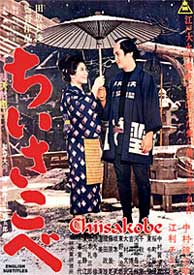 The same director worked with Kinnosuke for the two-part Story of Shinran the Priest (Shinran, 1960) & Return of Shinran (Zoku Shinran, 1960) based on a novel by Eiji Yoshikawa. Kinnosuke plays the famous Zen priest Shinran Shonin (1173-1262). It is a time when the old imperial rule is fading & a warrior class is growing in political strength, the nation in upheavel & radical change. The same director worked with Kinnosuke for the two-part Story of Shinran the Priest (Shinran, 1960) & Return of Shinran (Zoku Shinran, 1960) based on a novel by Eiji Yoshikawa. Kinnosuke plays the famous Zen priest Shinran Shonin (1173-1262). It is a time when the old imperial rule is fading & a warrior class is growing in political strength, the nation in upheavel & radical change.
Shinran, born of the fading aristocratic class, was placed in a monastary on Mount Hei when still a child. He did not come down for twenty years, when his wanderings begin as he spreads his ideas for achieving enlightenment through the Pure Land sutra. Because his teachings contradict the powerful Tendai sect, he comes to grief with the government, his followers persecuted, himself exiled to far coastal Echigo where he married & began raising a family but soonafter was wandering & teaching again. He lived to be ninety.
They again worked to gether on Chiisakobe (Carpenter & Children, 1962) about a good-hearted carpenter of Edo who attempts to restore his business after a fire, while at the same time helping orphaned kids. He could convince an audience he was anything, whether a holy saint or a struggling townsman. It's video case art is shown by this paragraph.
Although to the world at large Toshiro Mifune was Japan's biggest star, for domestic consumption the biggest post-war star was Kinnosuke Nakamura, who changed his name to Kinnosuke Yorozuka, but pretty much became affectionately just "Kinnosuke" to eager film goers. He was the Toei studios cash cow & a very versatile actor especially in period films. While many actors developed a single image, Kinnosuke was able to "become" a wide variety of characters & archetypes from Japanese history or legend or everyday life.
He studied each role with intensity before going in front of a camera, & attempted to create distinct characters, unlike so many stars who were encouraged to play a single character type again & again, or weren't even capable of broader range.
In some films he was a happy-go-lucky children's or family film star, but then in the same year he might play in something gruesome & fully adult like the grisly Shark or Bushido Samurai Saga (Bushido zankoku monogatari, 1963), this latter giving him a chance to play several roles in consecutive generations from rugged old warrior to young court catamite.
He could play a role as stoic & pitifully heroic as in Conspirator (Hangyaku, 1966), noble to the highest degree as in Swords of Vengeance: Fall of Ako Castle (Ako-jo danzetsu, 1978), cowardly & appalling as in Ambush (Machibuse, 1970), or zealously holy as in Nichiren (1979). He could perform in a dark range from machievellian to outright evil, i.e., from Shogun's Samurai: Yagyu Conspracy (Yagyu ichizoku no inbo, 1978) to Portrait of Hell (Jigokuhen, 1969), then still be accepted as that good-lookin' happy-go-luck guy in another project.
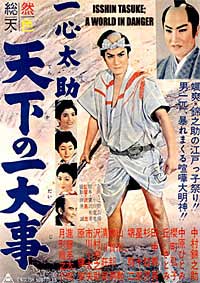 The acclaimed Japanese film critic Donald Richie dismissed Kinnosuke as a teen idol type of star only, a justifiable posture if judging him on the basis of a children's epic like The Ghost Ship (Yurei-sen, 1957) in which he plays a sea-captain's dewy-eyed orphaned son whose desire to become a samurai is unutterably naive. The acclaimed Japanese film critic Donald Richie dismissed Kinnosuke as a teen idol type of star only, a justifiable posture if judging him on the basis of a children's epic like The Ghost Ship (Yurei-sen, 1957) in which he plays a sea-captain's dewy-eyed orphaned son whose desire to become a samurai is unutterably naive.
But I have always felt he was a great actor from the start, & kept an artist's integrity in balancing commercial or lightweight roles with hard-hitting or sophisticated roles. But then, I always loved him even in the lightweight films, & about as far to the opposite end of the scale from the grisly Shark is the "Isshin Tasuke" series.
In this series, Kinnosuke played an Edo fishmonger full of good humor & quick to brave action, a "chivalrous peasant" or "town knight" (otokodate).
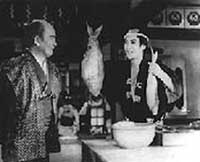 There were five episodes in all: Edo no meibutsu otoko Isshin Tasuke (Fishmonger of Edo, 1958); Isshin Tasuke: Tenka no ichi-daiji (Hero of the Town aka A World in Danger aka Tasuke's Desire for World Peace,1958); Isshin Tasuke: Otoko no Naka no Otoko Ippikei (The Bravest Fishmonger, 1959); Iyemitso to Hokosa to Isshin Tasuke (The Shogun & the Fishmonger, 1961), & Sarariman Isshin Tasuke (Tasuke the Salary Man, 1962), all directed by Chu Sawashima aka Tadashi Sawashima. The still & the DVD box illustration near this paragraph are both from the second Isshin Tasuke film. There were five episodes in all: Edo no meibutsu otoko Isshin Tasuke (Fishmonger of Edo, 1958); Isshin Tasuke: Tenka no ichi-daiji (Hero of the Town aka A World in Danger aka Tasuke's Desire for World Peace,1958); Isshin Tasuke: Otoko no Naka no Otoko Ippikei (The Bravest Fishmonger, 1959); Iyemitso to Hokosa to Isshin Tasuke (The Shogun & the Fishmonger, 1961), & Sarariman Isshin Tasuke (Tasuke the Salary Man, 1962), all directed by Chu Sawashima aka Tadashi Sawashima. The still & the DVD box illustration near this paragraph are both from the second Isshin Tasuke film.
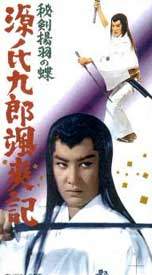 He was yet again an altogether different sort in what became a trilogy: Genjikuro sassoki: Nurekami nitoryo (Genji Kuro's Two Sword Style, aka, Tales of Young Genji Kuro, 1957) & Genjikuro sassoki: byakko nitoryo (White Tiger Sword of Genji Kuro, 1958) both directed by Tai Kato (from his first screenplay), followed up by Genjikuro sassoki: hiken ageha no cho (1962) directed by one of the greatest jidai-geki directors, Daisuke Ito. He was yet again an altogether different sort in what became a trilogy: Genjikuro sassoki: Nurekami nitoryo (Genji Kuro's Two Sword Style, aka, Tales of Young Genji Kuro, 1957) & Genjikuro sassoki: byakko nitoryo (White Tiger Sword of Genji Kuro, 1958) both directed by Tai Kato (from his first screenplay), followed up by Genjikuro sassoki: hiken ageha no cho (1962) directed by one of the greatest jidai-geki directors, Daisuke Ito.
In these Kinnosuke plays Genjikuro, a gambler by day, but by night a white-clad nobleman & avenger who fights with two swords, rather similar to Zorro or the Scarlet Pimpernel. Skirting an element of fantasy, Genjikuro is a descendant of the much-legended national hero Yoshitsune & inherited the Sacred Sword. The DVD box illustration near this paragraph is for the third of the trio of films. The illustration at the very top of the page is for the first in the set.
In Tomu Uchida's six-film series about Musashi Miyamoto, Kinnosuke was again a two-sword master, but the direct opposite of selfless Genjikuro because Musashi was too self-centered & ambitious to be anyone's chivalrous avenger.
These hint adequately at the range of this versatile actor, & you can follow hyperlinked titles above for reviews of a few more starring Kinnosuke, as well as Secret of the Urn (Tange Sazen: Hien iai-giri, 1966); Magoichi Saga (Shirakurae Magoichi, 1969), Lone Yakuza (Kutsukane Tokijiro yukyo ippiki, 1966), Shogun's Destiny (Tokugawa ichizoku no houkai, 1980), Yatappe the Killer (Seki no Yatappe, 1963), & The Shogun Assassins (Sanada Yukimura no bouryaku, 1979), which list does not exhaust the Kinnosuke films reviewed at the Weird Wild Realm.
copyright © by Paghat the Ratgirl
|
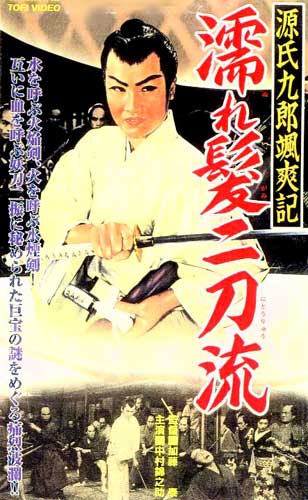

 Same participates in a hugely staged battle which is shown to be clumsy, unheroic, brutal & dirty.
Same participates in a hugely staged battle which is shown to be clumsy, unheroic, brutal & dirty.

 There were five episodes in all: Edo no meibutsu otoko Isshin Tasuke (Fishmonger of Edo, 1958); Isshin Tasuke: Tenka no ichi-daiji (Hero of the Town aka A World in Danger aka Tasuke's Desire for World Peace,1958); Isshin Tasuke: Otoko no Naka no Otoko Ippikei (The Bravest Fishmonger, 1959); Iyemitso to Hokosa to Isshin Tasuke (The Shogun & the Fishmonger, 1961), & Sarariman Isshin Tasuke (Tasuke the Salary Man, 1962), all directed by Chu Sawashima aka Tadashi Sawashima. The still & the DVD box illustration near this paragraph are both from the second Isshin Tasuke film.
There were five episodes in all: Edo no meibutsu otoko Isshin Tasuke (Fishmonger of Edo, 1958); Isshin Tasuke: Tenka no ichi-daiji (Hero of the Town aka A World in Danger aka Tasuke's Desire for World Peace,1958); Isshin Tasuke: Otoko no Naka no Otoko Ippikei (The Bravest Fishmonger, 1959); Iyemitso to Hokosa to Isshin Tasuke (The Shogun & the Fishmonger, 1961), & Sarariman Isshin Tasuke (Tasuke the Salary Man, 1962), all directed by Chu Sawashima aka Tadashi Sawashima. The still & the DVD box illustration near this paragraph are both from the second Isshin Tasuke film.